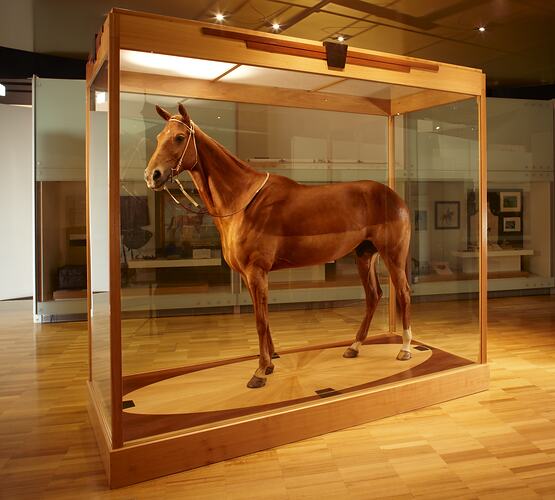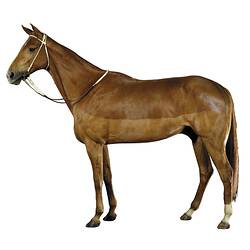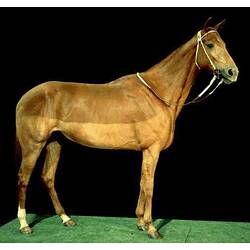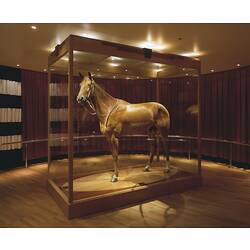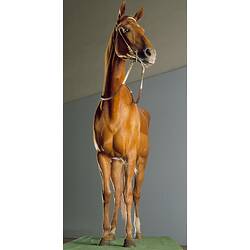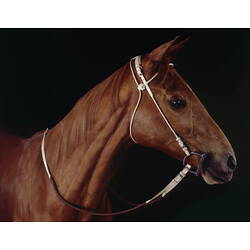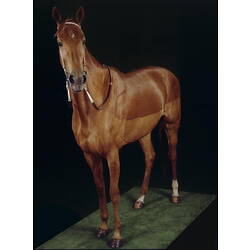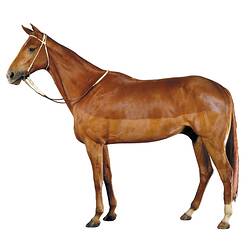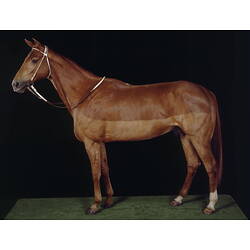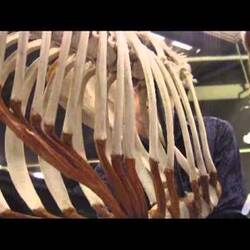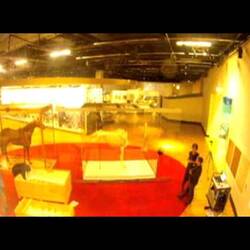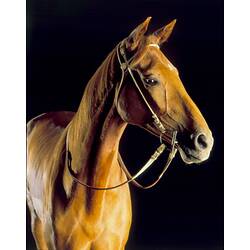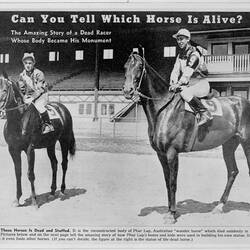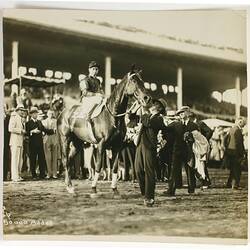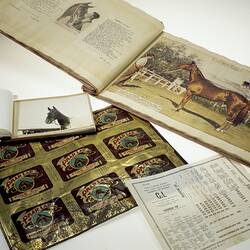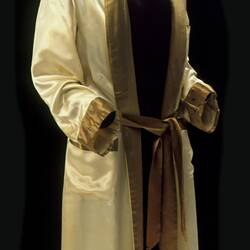Summary
Prepared hide of the racehorse Phar Lap, prepared by Jonas Brothers Studio, New York, 1932.
Phar Lap was born on 4 October 1926 at the Seadown Stud of breeder A.F. Roberts, near Timaru on the South Island of New Zealand. He was foaled from the sire Night Raid and mare Entreaty, with an impressive pedigree that included such greats as the English racehorses Doncaster (1870-1892), Bend Or (1877-1903) and St Simon (1881-1908), and the New Zealand born Carbine (1885-1914), winner of the 1890 Melbourne Cup.
Listed simply as 'Lot 41', he was purchased on the recommendation of Sydney trainer Harry Telford, by the American-born businessman David J. Davis, for 160 guineas (£168), at the Annual New Zealand Thoroughbred Yearling Sales, at Trentham Racecourse in January 1928. He was registered as a racehorse under the name 'Phar Lap' by Davis on 3 December 1928 and began racing in Sydney early in the following year. After an unimpressive start as a two-year-old, Phar Lap finally found form to win the Rosehill Guineas in September 1929. From that point on he had an impressive run of 36 wins from 41 races, including wins in the AJC Derby, Victoria Derby, W.C. Cox Plate (twice), Futurity Stakes and the 1930 Melbourne Cup, which he won as the shortest priced favourite on record.
His best known jockeys were Jim Pike (1892-1969), with 27 wins from 30 starts, and Billy Elliot (1908-1941), with 7 wins from 7 starts.
His feats captured the public's imagination during the early years of the Great Depression and his successes were eagerly followed through the new mediums of radio and cinema newsreels.
After failing to win the 1931 Melbourne Cup, carrying a race-record handicap weight of 10 stone 10 lbs (68 kg), Phar Lap was shipped to America, where he won the US$50,000 Agua Caliente Handicap at Tijuana, Mexico, on 20 March 1932. It was to be his last race. Two weeks later news was flashed across the globe that Phar Lap had died suddenly from a mysterious illness at Menlo Park, California on 5 April 1932. A subsequent autopsy suggested that the probable cause of death was either colic or a bacterial infection leading to severe stomach and intestinal inflammation, however, traces of arsenate of lead were also found in his stomach, leading to speculation that he may have been accidentally or intentionally poisoned.
Davis arranged for Phar Lap's hide to be preserved and mounted in New York and it was offered to the National Museum of Victoria in Melbourne, where it first went on display in January 1933. Phar Lap's skeleton is in the Museum of New Zealand, Te Papa Tongarewa in Wellington. His heart is in the National Museum of Australia, in Canberra.
Phar Lap's incredible career and tragic death have won him an enduring place in the heart of generations of Australians and he remains one of the Museum's most popular exhibits.
Specimen Details
-
Taxon Name
-
Preferred Common name
Horse
-
Number Of Specimens
1
-
Sex
Male
-
Stage Or Age
adult
-
Specimen Nature
Nature: Mount, Form: Dry
-
Horse Depicted
-
Past Owner
Mr David J. Davis, Sydney, New South Wales, Australia, 1928-1932
-
Other Association (See Comments)
Harry Telford, 'Braeside Park', Mordialloc, Greater Melbourne, Victoria, Australia, 1928-1932
Harry Telford was the principal trainer of Phar Lap throughout his career and half-owner with Davis from February 1931. -
Other Association (See Comments)
Mr Tommy Woodcock, Mordialloc, Greater Melbourne, Victoria, Australia, 1929-1932
Tommy Woodcock was Phar Lap's strapper and primary carer. -
Collected By
Unknown
-
Category
-
Scientific Group
-
Discipline
-
Collecting Areas
-
Type of Item
-
Keywords
Horse Racing, Recreation, Sport, Melbourne Cup Racing Carnival, Racing Industry, Agua Caliente Handicap, Tijuana, Mexico, Museum History, Museum Exhibitions
Taxonomy
-
Kingdom
-
Phylum
-
Subphylum
-
Class
-
Order
-
Family
-
Genus
-
Species Name
caballus
Geospatial Information
-
Country
-
Precise Location
Timaru
